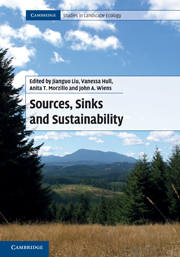Book contents
- Frontmatter
- Contents
- Contributors
- Preface
- Acknowledgments
- Part I Introduction
- Part II Advances in source–sink theory
- 2 Evolution in source–sink environments: implications for niche conservatism
- 3 Source–sink dynamics emerging from unstable ideal free habitat selection
- 4 Sources and sinks in the evolution and persistence of mutualisms
- 5 Effects of climate change on dynamics and stability of multiregional populations
- 6 Habitat quality, niche breadth, temporal stochasticity, and the persistence of populations in heterogeneous landscapes
- 7 When sinks rescue sources in dynamic environments
- 8 Sinks, sustainability, and conservation incentives
- Part III Progress in source–sink methodology
- Part IV Improvement of source–sink management
- Part V Synthesis
- Index
- References
2 - Evolution in source–sink environments: implications for niche conservatism
Published online by Cambridge University Press: 05 July 2011
- Frontmatter
- Contents
- Contributors
- Preface
- Acknowledgments
- Part I Introduction
- Part II Advances in source–sink theory
- 2 Evolution in source–sink environments: implications for niche conservatism
- 3 Source–sink dynamics emerging from unstable ideal free habitat selection
- 4 Sources and sinks in the evolution and persistence of mutualisms
- 5 Effects of climate change on dynamics and stability of multiregional populations
- 6 Habitat quality, niche breadth, temporal stochasticity, and the persistence of populations in heterogeneous landscapes
- 7 When sinks rescue sources in dynamic environments
- 8 Sinks, sustainability, and conservation incentives
- Part III Progress in source–sink methodology
- Part IV Improvement of source–sink management
- Part V Synthesis
- Index
- References
Summary
Demographic sources and sinks arise from the interplay of spatial variations in birth and death rates, and movement between habitats. One way to view sources and sinks is that, in the former, individuals are well adapted to the local environment, whereas in the latter, individuals are poorly adapted. This raises the question of how adaptive evolution might influence the evolutionary stability of source–sink population structures. When can a species’ niche evolve, so that a habitat – now a sink – becomes a source? This chapter provides an overview of theoretical investigations into this question. The scenarios considered include the fate of single favorable mutants that improve adaptedness to a sink environment, quantitative genetic variation for single traits determining local fitness, and the influence of reciprocal dispersal from sinks to sources. The overall conclusion across models is that the harsher the sink (as assessed in terms of absolute fitness), the harder it may be for adaptive evolution to sculpt adaptation sufficiently to permit population persistence. Theoretical studies show that the rate of immigration can have a variety of impacts upon evolution in sinks, depending upon many details of genetics, life history, and demography. Such theoretical exercises are not merely academic exercises, because source–sink dynamics naturally arise in a wide range of applied evolutionary contexts (such as the control of agricultural pests, and in disease emergence across host species) where the management aim is to prevent evolution in focal species in particular habitats.
- Type
- Chapter
- Information
- Sources, Sinks and Sustainability , pp. 23 - 57Publisher: Cambridge University PressPrint publication year: 2011
References
- 8
- Cited by

